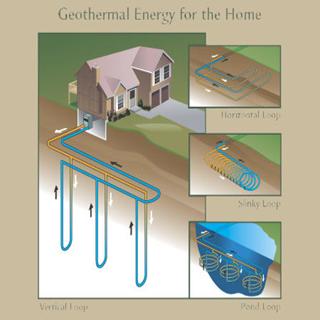

|
What is Geothermal Heating & Cooling |
|
Truly the most energy efficient products we offer will save you real money and economy be the best investment you will make, reducing energy consumption. Every dollar you save in energy goes straight to the bottom line! |

|
Thermco Energy Systems |
|
Since the temperatures above ground change a lot from day to day and season to season, temperatures in the upper 10 feet of the Earth's surface hold nearly constant between 50 and 60 degrees Fahrenheit. For most areas, this means that soil temperatures are usually warmer than the air in winter and cooler than the air in summer.
With this being true, what is also in contact with the earth shall be considered Geothermal Sources. Most rivers, lakes, ponds, and swimming pools relevant to regional location has its own Geothermal Energy. |


|
Summer
Winter |

|
Geothermal energy is heat from within the earth. The word Geothermal comes from the Greek words geo (earth) and therme (heat). There are numerous applications to how this technology is being used today. Utilizing geothermal for heating and cooling has been proven to be the most efficient way to save energy. While there are several ways to apply this technology there is still a need for geothermal exchangers. Geothermal heat pump systems or ground source heat pumps (GSHP) are known by a variety of names, including geo-furnace, geo-exchange, earth-coupled, earth energy, or water-source heat pumps, which are needed for a central heating and/or cooling system to pump heat to or from the earth. In the winter they use the earth as a heat source and in the summer is used as a heat sink. This design takes advantage of the moderate temperatures in the ground to gain efficiency and reduce the operational costs of heating and cooling systems. |
|
With the cost of energy rising, businesses and homeowners need to utilize alternative and renewable energy sources. The geothermal performance has been proven to be reliable and a heat pump system offers huge savings on your heating and cooling bills. |
|
Four basic types of geothermal ground loop systems The closed loops are horizontal loop, vertical loop, river-pond-lake loop, and the fourth loop is a open loop. The best design to choose depends on the climate, soil conditions, available land space, and local installation costs at the site. All of these applications can be used for residential and commercial building. |
Geothermal Loop Systems |
Geothermal Horizontal LoopsThis type of installation is found to be the most cost-effective for residential installations, particularly for new construction where land space is available. It requires trenches at least four feet deep. There are several layout designs available. The first is a two pipe, one buried at six feet, and the other at four feet, or two pipes installed side-by-side at five feet in the earth in a two-foot wide trench. The second is a circle or Slinky style. This allows more pipes in a tighter area, which normally cuts down on installation costs and makes the horizontal style of installation possible. Then leads back to the building where it is connected to a geothermal heat pump. |
Geothermal Vertical LoopsVertical loops are used where the soil is shallow for trenching, minimizes the disturbance of landscaping, and the land area required for horizontal loops would be restricted. This design is often used in commercial, business, and schools. The vertical geothermal loop installation uses holes (approximately four inches in diameter) which are drilled about 20 feet apart and 100–400 feet deep. There may be several of these in installed depending on the design. Two pipes are inserted and connected at the bottom with a U-bend to form a loop and then they are connected with horizontal pipe called a manifold which is placed in trench leading back to the geothermal heat pump in the building. |
Geothermal River – Pond - Lake LoopsWe call this a hybrid geothermal system and are very unique in design. If the Pond or Lake is adequate in size, this may be the lowest cost option. There is several design applications. One is to run two lines (pipes) underground from the building to the river, lake, or pond and a unique designed coil is placed at least eight feet under the water surface, this is to prevent freezing. The coil should only be placed in a water source that meets minimum volume and depth. This design is a closed loop geothermal system and is connected to a geothermal water source heat pump. If a open water to water system is used, it will pull water from the hybrid source and lead to a water to water source geothermal heat pump then be discharged back to the hybrid source. This geothermal design may require special permits. All geothermal designs offer several ways to save you real money and using the right heat pump system will provide even more options in saving other cost. To learn more on hybrid geothermal systems, please see our products. |